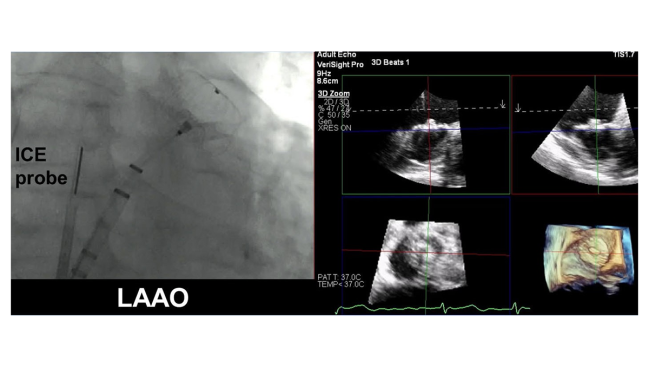Essentials for 3D-ICE in Structural Interventions Explored in Position Statement
The new paper sums up the basics for clinicians who are starting to use 3D intracardiac echo, with an eye toward the future.

Photo Credit: Adapted from Tang GHL, et al. JACC Cardiovasc Imaging. 2024;Epub ahead of print.
At a time when 3D intracardiac echo (3D-ICE) is gaining traction in structural interventions, a new position statement published in JACC: Cardiovascular Imaging provides guidance on what’s known about the imaging modality and how best to use it.
Both structural interventions as a whole and 3D-ICE itself have evolved in recent years, said Gilbert H.L. Tang, MD (Mount Sinai Health System, New York, NY), so the time was right to pull together a document that summarizes key topics related to indications, training, and future needs.
Their goal in writing it, Tang told TCTMD, was to explore the question: “Can we make this teachable and standardize the workflow so people out there who are starting to use these imaging technologies are able to do it reproducibly, safely, and effectively?”
The position statement, with Tang and Syed Zaid, MD (Baylor College of Medicine, Michael E. DeBakey VA Medical Center, Houston, TX), as lead authors, was published online Thursday to coincide with New York Valves 2024, previously known as the TVT meeting.
“[It] covers essential aspects such as the fundamentals of 3D-ICE imaging, basic views, and workflow recommendations specifically tailored for ICE-guided structural heart procedures, such as transseptal puncture, device closure of intracardiac structures, and transcatheter mitral and tricuspid valve interventions,” the paper notes. “Current challenges, future directions, and training requirements to ensure operator proficiency are also discussed, thereby promoting the safety and efficacy of this innovative imaging modality to support its expanding clinical applications in the future.”
Additional documents on this topic are in the works from the American Society of Echocardiography as well as the Society for Cardiovascular Angiography and Interventions, said Tang. He hopes that their new work “can serve as a blueprint or template for the other documents to follow, so at least there’s some agreement and harmonization.”
Taking on the ‘Gold Standard’
Up for discussion, as highlighted by the position statement, is whether 3D-ICE can be used as an alternative to transesophageal echocardiography (TEE) or should be considered a complementary approach.
“TEE, while it’s the gold standard, has some potential limitations,” Tang said. These include the need for a dedicated anesthesiologist and imaging expertise as well as issues with patient comfort.
On the other hand, Tang continued, TEE continues to advance. On the horizon is a TEE “microprobe made by Philips that is small in caliber, can increase patient comfort, reduce potential risks, and may be performed without general anesthesia, just with deep sedation.”
By contrast, 3D-ICE has limitations relating to image resolution and field of view but is a very safe technology. “I think the biggest question is [whether it’s] ready for prime time as a stand-alone technology,” said Tang. Even now, it’s “not unreasonable” in straightforward anatomy like LAAO—which is where most of the evidence to date, while sparse, lies—or in closure procedures for patent foramen ovale or atrial septal defects, he continued.
“[With] anything that’s more complex, for example mitral and tricuspid interventions, I think that this should be more of a complement, rather than an alternative, unless a patient has a contraindication to TEE insertion.”
Other factors that will impact wider adoption are operator comfort, the cost of single-use catheters and software grades, and reimbursement for imaging.
Training will also be essential, Tang and colleagues stress. “ICE catheter manipulation, image acquisition and interpretation differ significantly from other echocardiographic techniques and warrant dedicated training. Competency in ICE requires intimate knowledge of cardiac anatomy, familiarity with the catheter manipulation, and successful image interpretation,” they write, giving specifics on the necessary ingredients for didactic programs, hands-on training, clinical experience, and minimal procedure volume.
The companies Siemens, Philips, and GE Healthcare/Biosense Webster each have 3D-ICE imaging tools on the market, and other manufacturers have products in development. With further iterations, “it’s conceivable that in the next 5 to 10 years that the ultrasound technology [used in 3D-ICE] will be as good if not better than TEE, so that [intracardiac] imaging can be perhaps the preferred approach . . . in structural heart interventions,” said Tang.
As for future trials, Tang noted that while it might be possible to randomize patients between 3D-ICE and TEE guidance, this research would be difficult to fund. Moreover, there are enrollment issues that come with equipoise and potential implicit bias in terms of baseline anatomy. Registries, perhaps in collaboration with industry, are another option to pursue, he suggested.
Caitlin E. Cox is News Editor of TCTMD and Associate Director, Editorial Content at the Cardiovascular Research Foundation. She produces the…
Read Full BioSources
Tang GHL, Zaid S, Hahn RT, et al. Structural heart imaging using 3-dimensional intracardiac echocardiography: JACC Imaging position statement. J Am Coll Cardiol Img. 2024;Epub ahead of print.
Disclosures
- Tang has received speaking honoraria and served as a physician proctor, consultant, advisory board member, TAVI publications committee member, APOLLO trial screening committee member, and IMPACT MR steering committee member for Medtronic; has received speaking honoraria and served as a physician proctor, consultant, advisory board member and TRILUMINATE trial anatomic eligibility and publications committee member for Abbott Structural Heart; has served as an advisory board member for Boston Scientific and JenaValve and a consultant for NeoChord, Shockwave Medical, Peija Medical and Shenqi Medical Technology; and has received speaking honoraria from Siemens Healthineers.
- Zaid reports no relevant conflicts of interest.



Comments